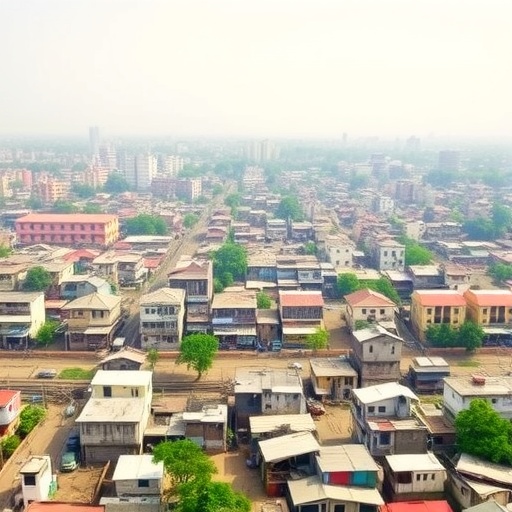Urban sprawl stands as a pressing issue in contemporary urban studies, revealing the complex interrelations among socio-economic factors, land usage, and ecological outcomes. A pertinent case study on this phenomenon is found in Varanasi, India, a city steeped in rich heritage yet facing rapid urbanization and suburban expansion. Researchers D.K. Jha, J.K. Dansana, and N.J. Behera delve into this topic with an integrated spatial and statistical analysis aimed at understanding the multidimensional aspects of urban sprawl in Varanasi. Their findings contribute significantly to urban policy formations and offer a comprehensive view of the challenges confronting heritage cities today.
Urban sprawl signifies the uncontrolled expansion of urban areas into adjacent rural spaces, often driven by factors such as economic development, population growth, and increased mobility. In Varanasi, a city famous for its historical significance as a pilgrimage site, this phenomenon poses serious threats to both its cultural integrity and environmental health. The research undertaken by Jha and his colleagues utilizes advanced geographical information systems (GIS) and statistical modeling to assess the extent and impact of urban sprawl on this iconic city.
The integration of spatial and statistical analysis in the study allows for a nuanced understanding of land cover changes in Varanasi. By employing various quantitative measures, the research reveals how urbanization trends have altered the landscape, leading to significant transformations that compromise the historical and ecological fabric of the region. The alarming rate of land conversion from agricultural areas to residential and commercial units illustrates the challenges faced by planners and policymakers in conserving the city’s heritage.
Moreover, as the study unveils, the implications of urban sprawl extend beyond mere land cover changes. They touch upon socio-economic dynamics, including the displacement of local communities, increased infrastructure strain, and environmental degradation. The research thus underscores how urban sprawl can further exacerbate socio-economic disparities, often marginalizing lower-income groups who depend on the traditional lifestyles that are increasingly threatened by urban expansion.
A key element of the study is the evaluation of factors that facilitate urban sprawl. Among these, improved transportation networks, economic opportunities, and changes in demographic profiles are highlighted. The analysts discovered that better road connectivity leads to greater accessibility, prompting individuals and businesses to relocate towards the peripheries of Varanasi. This shift not only alters local economies but also results in fragmented communities, disrupting the social fabric that binds Varanasi’s diverse populace.
The methodology employed in the research reflects a cutting-edge approach to urban studies. By deploying remote sensing technology alongside demographic data, Jha et al. crafted a compelling narrative that visualizes the patterns of urban growth. Their visualization techniques illuminate the stark contrasts between heritage sites and burgeoning suburbia, which serves as a powerful reminder of the need for balanced urban planning.
In Varanasi, the confluence of natural, historical, and cultural resources makes the city a unique case for urban sprawl assessment. As the researchers emphasize, preserving the distinctive character of Varanasi necessitates deliberate and informed planning that prioritizes heritage conservation amid growth pressures. Urban planners and decision-makers can benefit greatly from insights derived from this research as they navigate the competing demands of development and preservation.
The findings also advise on sustainable development practices that could mitigate the adverse effects of urban sprawl. For example, incorporating green spaces into urban plans and employing heritage conservation strategies could help forge a symbiotic relationship between urban growth and cultural preservation. Such approaches would not only enhance the quality of life for residents but also attract tourists to the city, bolstering the local economy.
As the global trend of urbanization continues, Varanasi serves as a poignant example of the challenges faced by cities worldwide. While urban sprawl can bring economic benefits, it often comes at the cost of environmental and social stability. This research provides a vital framework for understanding these complexities, serving as a reference point for similar studies in other heritage sites facing analogous challenges.
The potential for broader application of the study’s findings cannot be understated. By establishing methods that can be replicated in other cities, Jha et al. significantly contribute to academic discourse in urban studies. Their analysis serves as a clarion call for a comprehensive approach to urban planning that includes multifaceted assessments of spatial data, socio-economic factors, and cultural significance.
Ultimately, the work highlights the urgent need for a paradigm shift in urban planning practices, particularly in cities with rich historical pasts like Varanasi. The implications of the research extend well beyond academic circles, urging policymakers, urban planners, and community stakeholders to take proactive measures in curbing the adverse effects of urban sprawl. The future of Varanasi, balancing modernization and heritage conservation, lies in such integrative and informed strategies.
By addressing the nuances of urban sprawl through rigorous analysis, this study reinforces the importance of evidence-based action in fostering sustainable urban ecosystems. Varanasi stands at a crossroads, reminiscent of many cities confronting similar dilemmas. Insights from this research not only emphasize the need for informed urban planning but also celebrate the rich heritage that must be preserved amid the relentless tide of urban expansion.
As cities continue to evolve, the narrative presented by Jha and his colleagues serves both as a warning and a guide, reinforcing the idea that urban development can, and indeed should, coexist with the preservation of cultural legacies. In doing so, the researchers chart a path for future explorations in urban studies, advocating for a harmonious relationship between growth and heritage that many cities aspire to achieve.
Subject of Research: Urban sprawl assessment in Varanasi, India.
Article Title: Urban sprawl assessment using integrated spatial and statistical analysis in the heritage city Varanasi, India.
Article References:
Jha, D.K., Dansana, J.K., Behera, N.J. et al. Urban sprawl assessment using integrated spatial and statistical analysis in the heritage city Varanasi, India.
Discov Cities 2, 89 (2025). https://doi.org/10.1007/s44327-025-00132-9
Image Credits: AI Generated
DOI: https://doi.org/10.1007/s44327-025-00132-9
Keywords: Urban sprawl, Varanasi, spatial analysis, statistical analysis, heritage preservation, urban policy.




